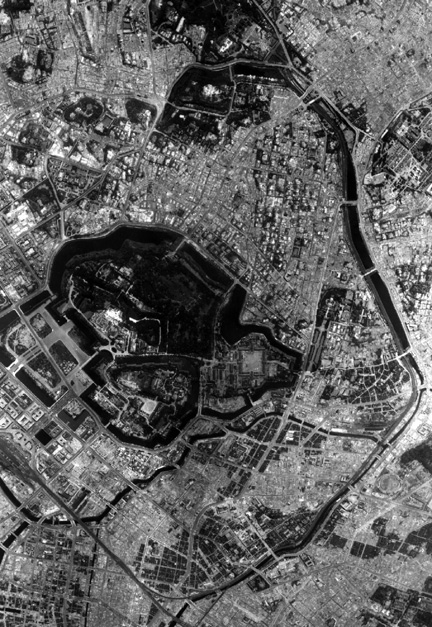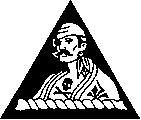
A photo of Tokyo taken on May 28.
Thanks to
Col
Clarence E. Becker for finding these photos. This was night incendiary mission involving 33 aircraft of the 6th Bomb Group:
Then came the Sixth's two roughest incendiary missions. Both were directed at Tokyo. They were on the
nights of 23-24 and 25-26 May. On these two raids the Sixth lost three crews, had a part of one crew bail out over Japan,
one plane ditched at Iwo harbor and the crew of another plane bail out over Iwo Jima. The first mission's cost was
twenty-eight crew members missing, and five wounded, one of whom died later. The second mission has been labeled the 20th
Air Force's roughest mission. Seventeen Superforts in all were lost by the four Wings participating.
The first mission sent thirty-five Sixth planes to Japan. Two were early returns, and thirty-one bombed the
target. Enemy opposition, especially anti-aircraft fire was heavy and nine planes were damaged. Two 24th Squadron planes
failed to return. Lt J. B. Boynton and Lt J. M.1
Snyder were the airplane commanders. Of Lt Boynton's crew all but Sgt Stephen Spega, Jr., were found in PW camps and
repatriated. Sgt Spega is still missing as well as all of Lt Snyder's crew.2
In addition to these losses, six members of Lt Jay K. Anderson's crew, of the 39th Squadron bailed out over
the Empire. Their plane was hit by both flak and fighter fire. The ship caught aflame, went into a spin, dropped from
10,000 feet to approximately 3000 feet before Lt Anderson could get it under control. The men who bailed out- Lt Harold
Anderson, F/O Mitchell, Sgt Boyko and Corporals Lounsbery, Sasser and Costello- mistook the command "Stand by to bail out"
and left the plane over enemy territory. Fortunately, they were found as prisoners of war and are alive today. Subsequently, the
remaining crew members were able to bring the aircraft back to Iwo Jima and effect a safe landing in spite of a
seventy-five foot ceiling.
On the same raid Lt Joseph Novak, Jr., 24th Squadron, co-pilot on crew No. 3906 was wounded by 20 mm
cannon fire from a Jap fighter and later died in a hospital on Tinian. Lt Sam Parks, airplane commander, although
suffering from a flak wound, brought the plane back to the Base unassisted. For this gallantry, he was later awarded the
Silver Star. Five other men were also wounded on this raid: S/Sgt Daniel V. Manfredi, a wound in his left arm; S/Sgt
Clarence E. Hitchcock suffered a fractured skull; Sgt Herman L. Anderson, a flak wound in the leg; Sgt Alfred Bienert,
received a broken arm in a crash landing at Iwo.
The cost was high for the Sixth, but much higher for the enemy. Uncontrollable fires raged over Tokyo
for hours after the attack. Eye witness reports written after V-J Day describe the 23 May raid as Tokyo's most terrific pounding.
[Pirate's Log, pp. 43-44]
Notes:
1. According to the Appendix and to the Missing Aircraft Report, Lt Snyder's middle initial was "H", not "M".
2. According to a later update to the Missing Aircraft Report, their status was later changed to KIA.
For a detailed account of this mission written by Sam Parks, the aircraft commander, see
"Co-Incidences- I Can't Believe It!"
According to the Silver Star Citation for 1/Lt Jay K.
Anderson:
For gallantry in action on a bombing mission against the
Japanese Empire 23 May 1945. Lieutenant ANDERSON was Airplane Commander of a
B-29 aircraft based in the Marianas Islands. On this raid, his plane was set
on fire and severely damaged by flak over Tokyo. The bomber fell
approximately 7500 feet before he was able to regain control. During this
time, through a misunderstanding of orders, six crew members bailed out
leaving only Lieutenant ANDERSON, his pilot, bombardier, radio operator, and
flight engineer in the plane. Although the aircraft continued to burn, and
all of the communications facilities were shot out or damaged, he succeeded
in keeping it in the air. Later he found and maintained the correct course
without a navigator. He finally reached Iwo Jima, with one engine still
burning, one propeller windmilling and the radio signal barely discernable.
Despite a seventy five foot ceiling, he made a brilliant landing. Lieutenant
ANDERSON'S fortitude and cool judgement under conditions of extreme
emergency, his high degree of technical skill in the face of imminent
catastrophe, and his resourcefulness in utilizing all means available in
saving his crew and his plane were in accordance with the highest traditions
of the service, and reflect great credit on himself and the Army Air Force.
[Transcribed by David Wilson, son of Sgt Bernard E. Wilson (Gunner, "Anonymous IV")]
According to the DFC Citation for Crew #2407 "Incendiary
Journey":
For extraordinary achievement while participating in
aerial flight 23 May 1945 from a base in the Marianas Islands. These
individuals were combat crew members of a pathfinder B-29 aircraft in a low
level night incendiary attack on important industrial facilities in the city
of Tokyo, Japan. On the bomb run, their plane was attacked by suicide planes
and damaged by heavy, accurate and intense flak, but despite this the attack
was pressed home and the target accurately located and bombed. The work of
this crew aided materially in the destruction of more than twenty-two square
miles of the built-up portion of Tokyo on this raid. The professional skill
and teamwork demonstrated by these veterans of repeated assaults against the
Japanese homeland reflect great credit on themselves and the Army Air
Forces.
First Lieutenant IRVIN E. QUALIZZA as Navigator
First Lieutenant JOHN T. HART as Bombardier
Master Sergeant RICHARD C. DIMMIG as Flight Engineer
Staff Sergeant NEWELL O. FEARS as Radio Operator
Staff Sergeant RICHARD D. FORINGER as Central Fire Control Gunner
Staff Sergeant LESTER J. ROUSSEAU as Radar Gunner
Staff Sergeant WALTER M. ZOLLER as Left Blister Gunner
Staff Sergeant JOHN F. CATALANO as Right Blister Gunner
Staff Sergeant EARL J. BERNDTSON as Tail Gunner
[Transcribed by David Wilson, son of Sgt Bernard E. Wilson (Gunner, "Anonymous IV")]
A separate DFC Citation was prepared for Captain CHARLIE
H. HOLTON, Aircraft Commander of #2407 on this mission.
According to the DFC Citation for Crew #2408:
For extraordinary achievement while participating in
aerial flight on 23 May 1945 from a base in the Marianas Islands. These
individuals were combat crew members of a B-29 in a low-level night
incendiary raid against important industrial facilities in Tokyo, Japan. In
the target area, their plane was caught in the concentrated beam of almost
one hundred searchlights; attacked by six aggressive fighter planes and
badly damaged by heavy, accurate anti-aircraft fire. The left waist gunner
shot down one Japanese fighter. The right gunner was wounded and the
starboard flight cables, all radio and identification equipment and the
number four engine was shot out. Despite this great damage, these veterans
of many missions against the home islands of Japan continued on to the
target, effectively dropping their bombs, damaging the objective severely.
The radio operator and bombardier administered first aid to the wounded man
while the pilot successfully piloted the plane to an emergency landing at
Iwo Jima, bringing the B-29 down safely without radio equipment although the
ceiling was only fifty feet. The work of this crew contributed materially to
the destruction of more than twenty-two square miles of the built up area of
Tokyo. Their professional skill, teamwork, determination and success in
carrying out the attack reflect great credit on themselves and the Army Air
Forces.
First Lieutenant RAMON L. HOLTZCLAW as Pilot
First Lieutenant ROBERT H. JOHNSTON (then Second Lieutenant) as Navigator
First Lieutenant EDWIN F. KEENEY, JR. (then Second Lieutenant) as Bombardier
Technical Sergeant GEORGE E. BENYO as Flight Engineer
Staff Sergeant CHARLES M. ALLEN as Radio Operator
Staff Sergeant STANLEY BALON as Central Flight Control Gunner
Staff Sergeant FLOYD S. HOVLAND as Right Gunner
Sergeant RICHARD J. BROWN as Left Blister Gunner
Sergeant ROBERT Y. MARCHBANKS as Tail Gunner
[Transcribed by David Wilson, son of Sgt Bernard E. Wilson (Gunner, "Anonymous IV")]
A separate DFC Citation was prepared for Captain ROBERT
P. FORTUNE, Aircraft Commander of Crew #2408.
According to the DFC Citation for Sgt John R. Creek:
Sergeant JOHN R. CREEK 39th Bombardment Squadron, 6th
Bombardment Group, Air Corps, United States Army. For Extraordinary
achievement while participating in a B-29 bombing mission from the Marianas
Islands against the Japanese Empire 23 May 1945. As Radio Operator on a
plane that had been severely damaged by flak over the target, and was on
fire and in constant danger of exploding, Sergeant CREEK displayed great
coolness, courage and technical skill in establishing the position and
proper course for the plane with much of it's communication equipment barely
functioning. Sergeant CREEK not only remained at his post, using every means
at his command to establish radio contact, but also successfully used
auxiliary navigational equipment of a highly technical nature in the use of
which he had received no formal training. By his courage in the face of
eminent catastrophe, his coolness and skill both in his own specialty and in
one that was not required of him and by his resourcefulness in overcoming
almost insuperable difficulties, Sergeant CREEK distinguished himself and
reflected great credit on the Army Air Force.
[Transcribed by David Wilson, son of Sgt Bernard E. Wilson (Gunner, "Anonymous IV")]
According to the DFC Citation for Crew #4001:
For extraordinary achievement while participating in
aerial flight on 24 May 1945. These individuals were combat crew members of
a B-29 aircraft on a night incendiary raid against important industrial
facilities in the city of Tokyo, Japan, flying from a base in the Marianas
Islands. The success of the mission depended on close coordination and
precise flying. As a result of the high degree of professional skill
displayed by each of these individuals, this plane reached the target area
at the briefed time and exactly along the planned course. Despite intense,
heavy, and accurate flak, a large number of searchlights, and aggressive
attacks by two enemy planes, one of which they destroyed, they released
bombs as briefed, materially aiding in the destruction of fifty percent of
the built-up portion of the city. Each of these veterans of repeated
assaults against the Japanese homeland distinguished himself on this mission
by outstanding performance of assigned tasks, by coolness and courage in the
face of great danger, thereby reflecting great credit on himself and the
Army Air Forces.
First Lieutenant WILLIAM M. MEADOR as Airplane Commander
First Lieutenant STANLEY WIRTSCHAFTER (then Second Lieutenant) as Navigator
First Lieutenant OSBORNE D. NICHOLS as Bombardier
Staff Sergeant JAMES H. WISEMAN, JR as Radar Gunner
Technical Sergeant JAMES W. SHELTON (then Staff Sergeant) as Central Fire
Control Gunner
Staff Sergeant GEORGE F. SAULS (then Sergeant) as Left Blister Gunner
Staff Sergeant JAMES I. MCCREA as Right Blister Gunner
Sergeant CHARLES J. RHEYNARD as Tail Gunner
[Transcribed by David Wilson, son of Sgt Bernard E. Wilson (Gunner, "Anonymous IV")]
|

